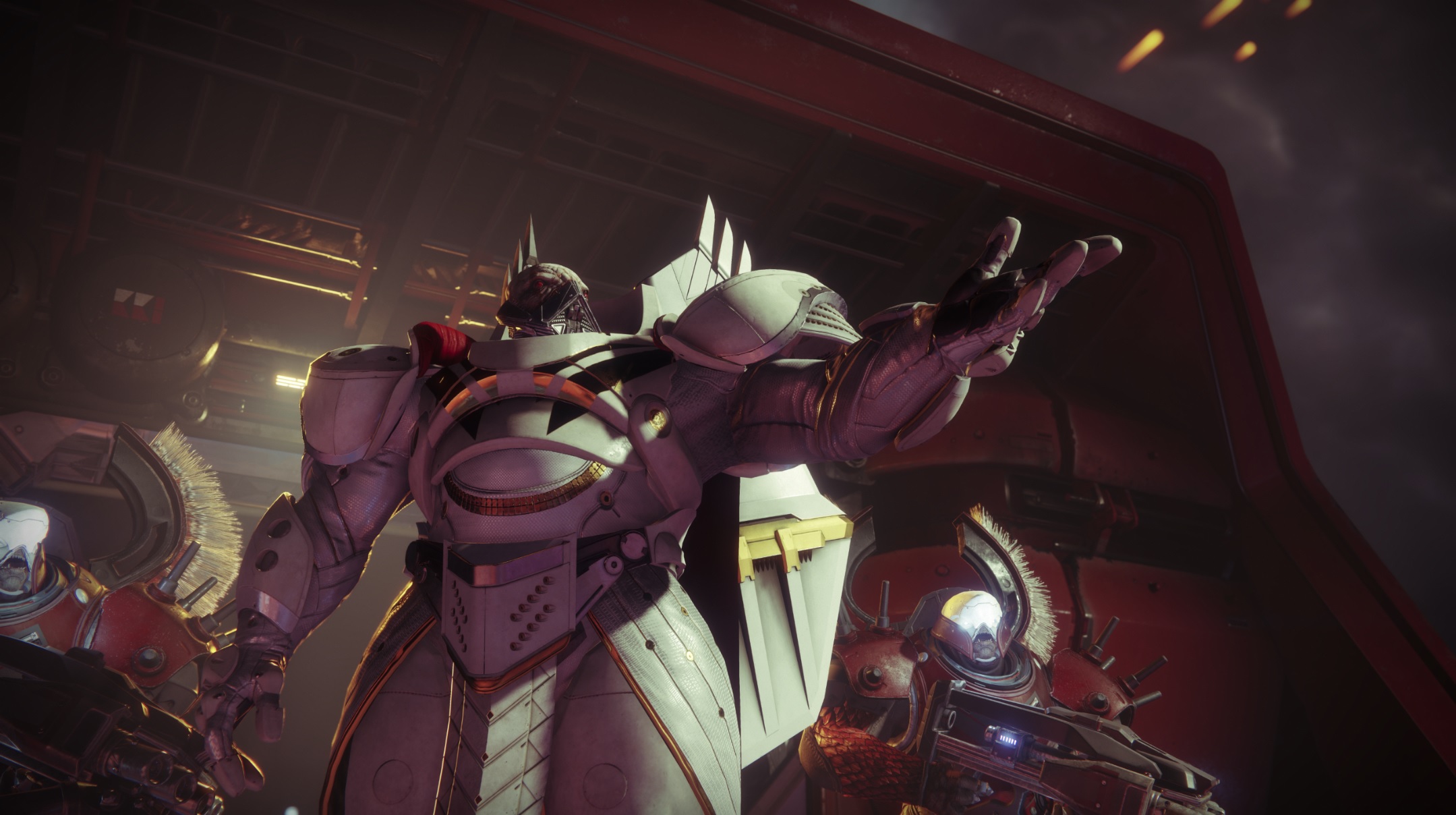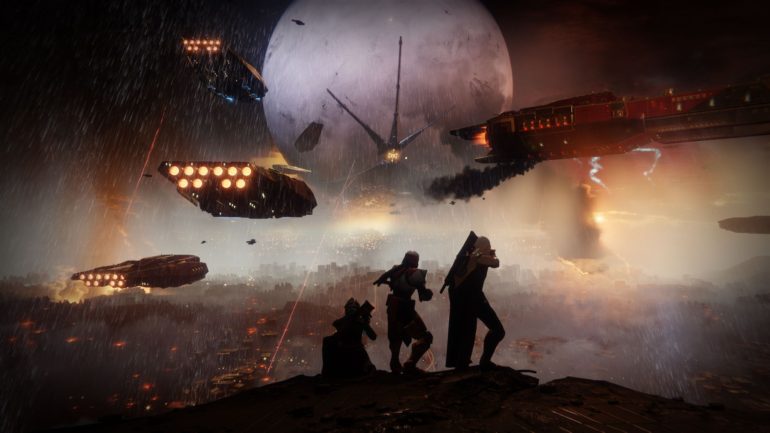To talk about Destiny 2 is to discuss the legacy, the evolution of what Bungie’s 2014 premiere title Destiny did, what it did wrong, and what it evolved into.
Most importantly, Destiny became the game that I know, that most know, and that really stepped up what games can do in the multiplayer space on console with its first major expansion, The Taken King. Destiny “Year Two” is what kicks off the legacy of Destiny, and also the clear path that Destiny 2 then follows the two years later in its release. Bungie created a game, a community, a world with tons of problems and caveats, and part of Destiny 2 is about embracing that lineage, but another huge part of it is leaving it behind in favor of something new. Something greater.
Destiny 2 feels like a fresh start, kind of how you imagine a game that leaves behind three years of content, story, missions, expansions, and most importantly, unique gear, weapons, levels and abilities behind should, but without losing the heart and soul that made Destiny special. For all intents and purposes, Destiny 2 is an open world RPG, formatted similarly to 2014’s Dragon Age Inquisition, interestingly enough. It gives you four massive areas to explore, the planet earth, and the three established moons that make up the other locations in the game. Each area has its own vibe, its own series of stories, secrets, and touchstones to explore. So far this is all in line with what Destiny 2’s predecessor laid out, but the key difference is format. Destiny 1 was not an open world RPG, Destiny 2 is.
What I mean by this is each area to explore in Destiny 2 feels like a place. You arrive, you touch down, check in with an NPC in the area, walk up to a place to start a sidequest or campaign mission, and go. Where the original had you jumping back to orbiting the planets and selecting destinations off a map, Destiny 2 is much more freeform, allowing you to touchdown and take in the sights, before just naturally walking to the next destination. Where this is certainly something we’ve seen before, it’s an improvement that the sequel embraces, cutting out the fat of returning to orbit, of decrypting every piece of loot you get, of just keeping you engaged with the game and not letting go.
Story Time
Part of that is the actual story of Destiny 2, which opens with the fall of The Last City, Earth’s final frontier, protected by the great white orb known as The Traveler. Taking the three major characters from Destiny’s expansion, the representatives of each of thethree major classes in Destiny, Cayde-6, Zavala, and Ikora, you follow their loss from the Cabal invasion of The Last City, and the Traveler and his light being taken from you and every other Guardian in the system. It’s great because of the emphasis on character, like the three mentioned above, but also the villain, Dominus Ghaul, leader of the Cabal’s Red Legion. Ghaul is not all you see at first glance, and his opinion on The Traveler, and how that evolves as the story goes on is super fascinating, all captured by his interactions with other characters, his backstory, and where he ultimately goes. Destiny 2’s narrative is held up by great set pieces and even better characters, all finding their own internal conflicts because of The Traveler and what he represents.

Destiny 2’s campaign, while great, is just one slice of the formatting changes that make Destiny 2 feel like a full sequel, something that stands above its predecessor instead of in its shadow. A lot of that is the story quests that unlock after finishing the game, the side quests available as you play (called ‘Adventures’), and the seemingly endless challenges, events, and alternative pathways to level and get loot.
Diversity of Options
Part of the original Destiny’s grind was getting to the hard level cap, and then getting to the “loot level cap”, then known as “Light Level”. This system returns pretty much in the same way, being called “Power Level”, functioning the same, a total sum average of your attack and defense stats from all of your weapons and all of your armor. What made the grind before was getting from where the story missions left you, say, at Light 220, and getting to the functional equipment level that let you access the hardest and most satisfying parts of the game, the raids, the Nightfall Strikes, and Trials, the only competitive play mode where Light or Power level is effective (or at least used to be, since it no longer plays a role). All these aspects return, and the grind to get to “raid ready”, or 260 Power, is still there. But it’s different.

Destiny would make you do similar community events to get slightly higher level loot, or run Strikes over and over again until you slowly crawl your average number up. Not only does Destiny 2 seems to give better rewards more often, but while the community events and strikes still help in the same way, there are numerous other ways to get to that soft level cap and get ready for the game’s final bits of content. Maybe if you’re a solo player, like me, you’ll end up doing the adventures and the post-game story quests, which will also reward you with more story and more loot. You can do Lost Sectors, secret dungeons hidden away that reset every week, redo adventures, earn specific loot targeted at replacing your weakest gear in Crucible, the competitive multiplayer, or things like Heroic Group Events in the open worlds and Strikes, just like before.
Not only is Destiny 2’s format faster, better, and just more enjoyable, but it also seems not only open to new players, but to more types of players. The single player has tons of dialogue-driven side quests to explore after finishing the story. The multiplayer focused person, that maybe only just likes competitive, can still get Raid Ready just by sinking time into that. And there is so much content to resee each week that you’ll probably either just do the things you like the most, or not be able to recycle all of Destiny 2’s content every week like you easily could even with the expansions before. If you’re into grind, it’s there, but if you’re not, doing everything once is more than enough to get you what you need to see the best content in the game.
This was such a major issue with the game before, and it feels almost as if the wound was never even there to begin with.
The Full Suite
Destiny 2 is the full suite of options this time, on top of being just a great shooter. If we’re talking about having different guns, equipping them, aiming down sights, and shooting them, this is the best on consoles. Destiny has never felt better, shooting the several different kinds of enemies has never felt better, and that’s in the whole spectrum from multiplayer to campaign.
 Multiplayer has gotten a big facelift this time too, with a switch from the six on six multiplayer of the original, to the more intimate four versus four. This has it’s pros and cons, with an introduction of a lot of new modes. It feels more intimate and the maps reflect this, scaling back the longer corridors in favor of sectional areas spread into arenas for total mayhem to rain down. It makes every player that much more essential, and makes it harder for a straggler in fourth place to either have nothing to do, or have room to bring the team down. It’s a rebalancing that adds a lot more tension and strategy to each match.
Multiplayer has gotten a big facelift this time too, with a switch from the six on six multiplayer of the original, to the more intimate four versus four. This has it’s pros and cons, with an introduction of a lot of new modes. It feels more intimate and the maps reflect this, scaling back the longer corridors in favor of sectional areas spread into arenas for total mayhem to rain down. It makes every player that much more essential, and makes it harder for a straggler in fourth place to either have nothing to do, or have room to bring the team down. It’s a rebalancing that adds a lot more tension and strategy to each match.
Just like the single player additions, this is a big change, and it feels like one for the better of the game and its balancing. Multiplayer is looked to be supported for some time to come, with big community events like Iron Banner, a special loot-driven event where the player’s level and gear matter, which has started here in October, and Trials of Osiris, now redubbed Trials of the Nine, a much more intense and competitive multiplayer mode where gear also matters, having already started as a weekend event. Multiplayer looks to be supported, just like single player always is with expansions and DLC, and with the new formatting of multiplayer, I’d expect it to be more competitive and intense on top of that.
Take it or Leave it
 I think the biggest takeaway I’ve had with Destiny 2 is that it really is the Destiny I think we deserved all along. I don’t subscribe to the idea that this is just Destiny 1.5, since I think there were some necessary problems that had to be learned from the original, and seeing them not present in Destiny 2 makes it feel more like a “legitimate” sequel, if that’s what you’d want to call it.
I think the biggest takeaway I’ve had with Destiny 2 is that it really is the Destiny I think we deserved all along. I don’t subscribe to the idea that this is just Destiny 1.5, since I think there were some necessary problems that had to be learned from the original, and seeing them not present in Destiny 2 makes it feel more like a “legitimate” sequel, if that’s what you’d want to call it.
I see Destiny 2 as a real broadening of the content. There is now a way for everyone, from the single-player focused player, to the competitive one, to earn their way into Destiny’s highest and most interesting content, like it’s first raid, the Leviathan, which is still the most interesting and intricate part about Destiny, now with even more layers on top that the original did not have. If you’d rather do side quests and take your time getting to the max level in the game, you can do that. If you’d rather repeat the same events over and over again to get to max level as quickly as humanly possible, you can do that too.
The thing with being an all around fuller Destiny experience is, it’s still Destiny. For better and for worse. Destiny is home to some of the most obtuse and interesting mechanics in a multiplayer video game, with an emphasis on cryptic secrets and hidden lore. But coupled with these cool ideas are the frustratingly vague and obscure processes needed to understand, execute on, and complete some of the game’s best content. From quests for special weapons to the big bad raid itself, Destiny is still weird. This also means that after the single player content is completed, there is a whole lot of doing the same or similar things again with a much slower trickle of rewards. The “grind”, to name it. I think the pacing of it all is infinitely better and more interesting than it has been before, but it’s still going to be an offputting ask for new players.
Closing Thoughts:
Destiny 2 is absolutely the best place to start your Destiny journey, but that also means if this doesn’t work for you, Destiny probably just isn’t going to at all. It makes everything that needed to be, better, and retains the weird and the obscure for the amazing moments of gratification, and also the long slogs of confusion and doubt. It’s a phenomenal game that is truly unlike anything else out there, and it’s still a lot to ask any player to get really, truly into it.
This review is based on a digital copy of Destiny 2 purchased by the reviewer on a Standard PlayStation 4 system. Reflective of the 1.0.3 version of Destiny 2.






